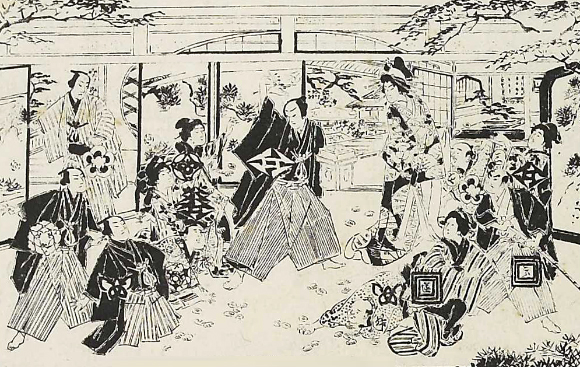Suehiro-za (Nagoya) on:
[Wikipedia]
[Google]
[Amazon]
 The Suehiro-za (末広座) was a ''
The Suehiro-za (末広座) was a ''
役割番附/名古屋末広座
1883 establishments in Japan Buildings and structures in Japan destroyed during World War II Former kabuki theatres History of Nagoya Sakae, Nagoya Theatres in Nagoya {{theat-stub
 The Suehiro-za (末広座) was a ''
The Suehiro-za (末広座) was a ''kabuki
is a classical form of Japanese dance- drama. Kabuki theatre is known for its heavily-stylised performances, the often-glamorous costumes worn by performers, and for the elaborate make-up worn by some of its performers.
Kabuki is though ...
'' theatre in Nagoya
is the largest city in the Chūbu region, the fourth-most populous city and third most populous urban area in Japan, with a population of 2.3million in 2020. Located on the Pacific coast in central Honshu, it is the capital and the most po ...
, central Japan. It was located in Suehiro-chō.
History
In Nagoya of the Meiji era at that time a number of theatres existed, such as the Chitose-za (千歳座) in Minamikuwana-machi (南桑名町), Shinmori-za (新守座) in Motoshige-chō (本重町), Onu-za (音羽座) in Minamifushimi-chō (南伏見町), Hoso-za (宝生座) in Ōsu, andMisono-za
The is a theatre in the city of Nagoya, central Japan. It was originally constructed in 1800s and presents ''kabuki'' and Western stage plays.
History
The tradition of ''kabuki'' in Nagoya goes back to the Edo period. With the opening of ...
. The theatre was founded under a different name originally in January 1883.
Among the many noted actors were Nakamura Denkurō VI (1859-1923), who was born in Suehiro-chō and became of a member of the children actors troupe at the Suehiro-za. Ichikawa Chūsha VII (1860-1936) and Ichikawa Danzō VII (1836-1911) appeared together in May 1909, as well as Nakamura Tokizō III (1895-1959) appeared here in May 1917.
The building was bought by Shochiku
() is a Japanese film and kabuki production and distribution company. It also produces and distributes anime films, in particular those produced by Bandai Namco Filmworks (which has a long-time partnership—the company released most, if not ...
, a cinema
Cinema may refer to:
Film
* Cinematography, the art of motion-picture photography
* Film or movie, a series of still images that create the illusion of a moving image
** Film industry, the technological and commercial institutions of filmmaking
...
chain which has its roots in ''kabuki'' production, and converted into a movie theatre in 1927. Under its new name Shochiku-za (松竹座) it became one of the leading cinemas in town and was also used for revue
A revue is a type of multi-act popular theatrical entertainment that combines music, dance, and sketches. The revue has its roots in 19th century popular entertainment and melodrama but grew into a substantial cultural presence of its own dur ...
shows. It was destroyed in the bombing of Nagoya in World War II.
References
External links
役割番附/名古屋末広座
1883 establishments in Japan Buildings and structures in Japan destroyed during World War II Former kabuki theatres History of Nagoya Sakae, Nagoya Theatres in Nagoya {{theat-stub